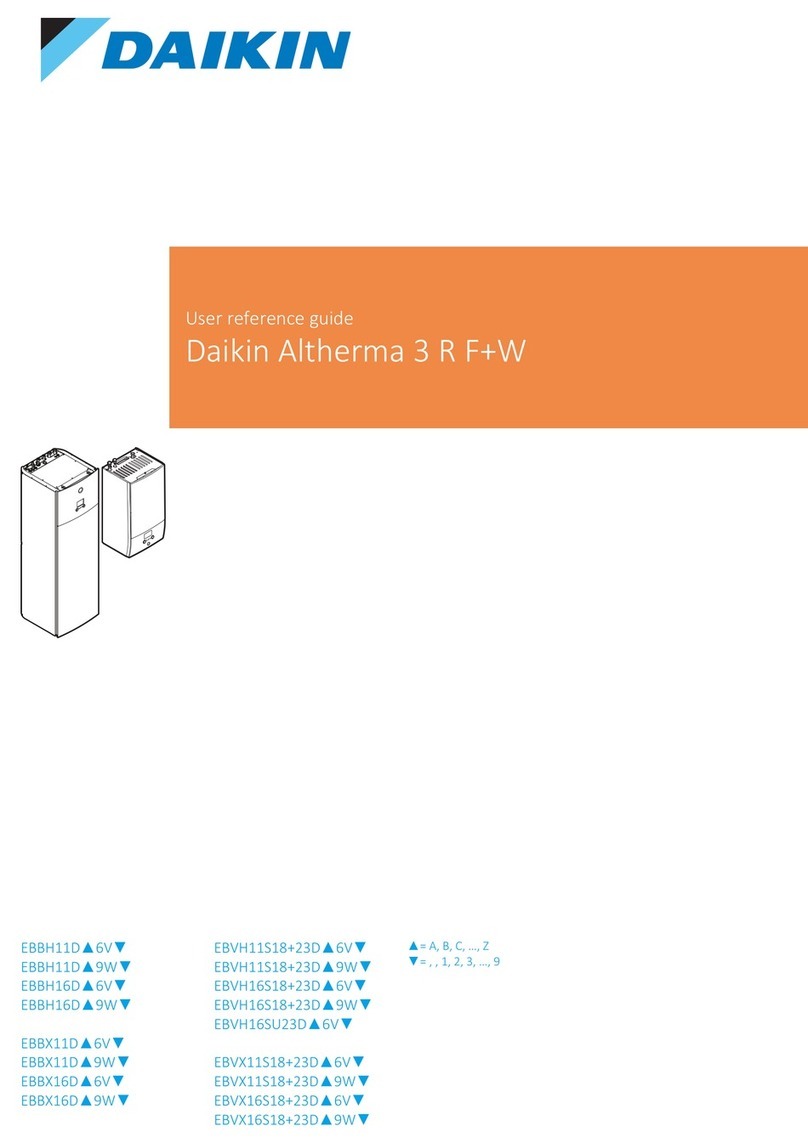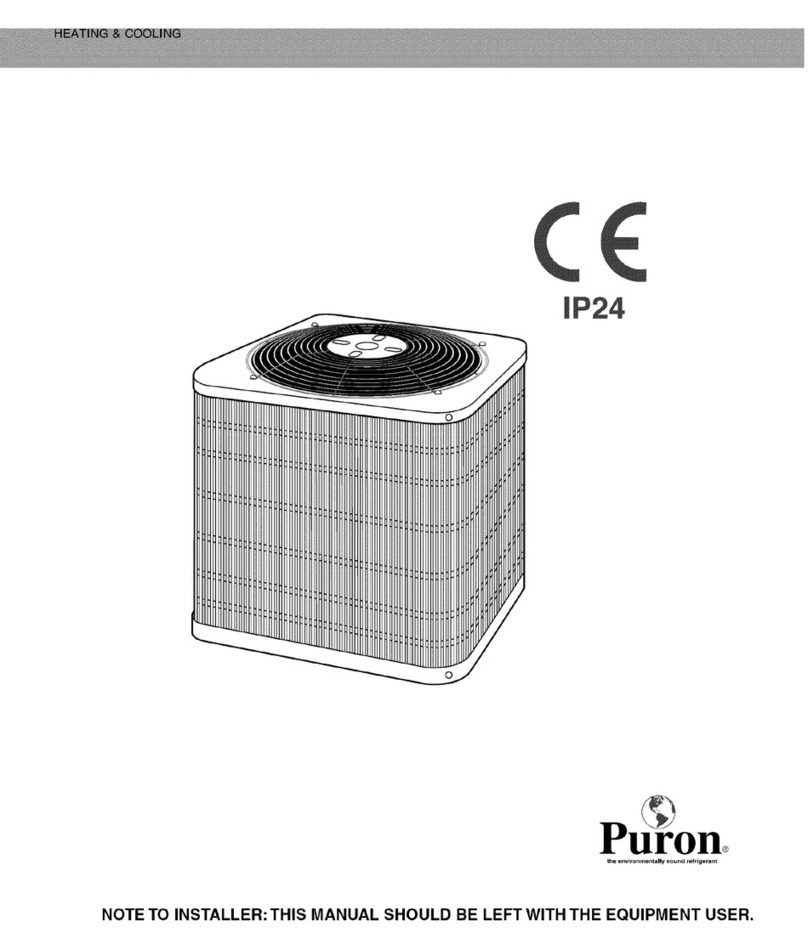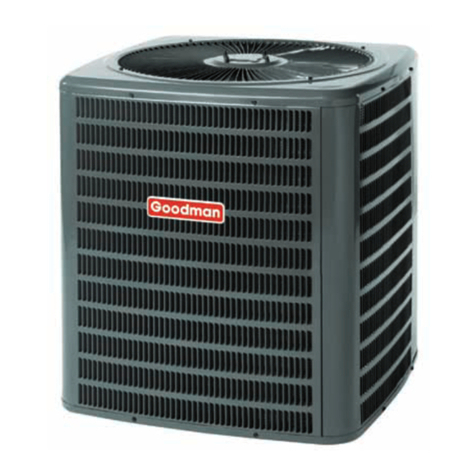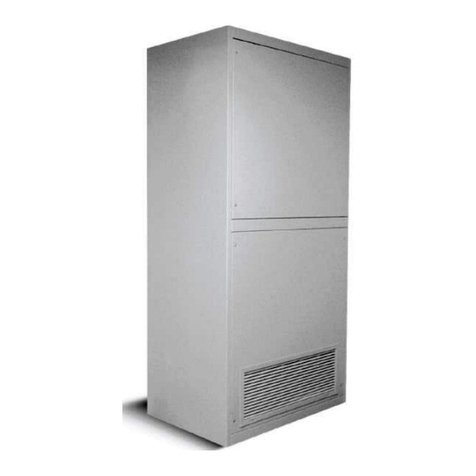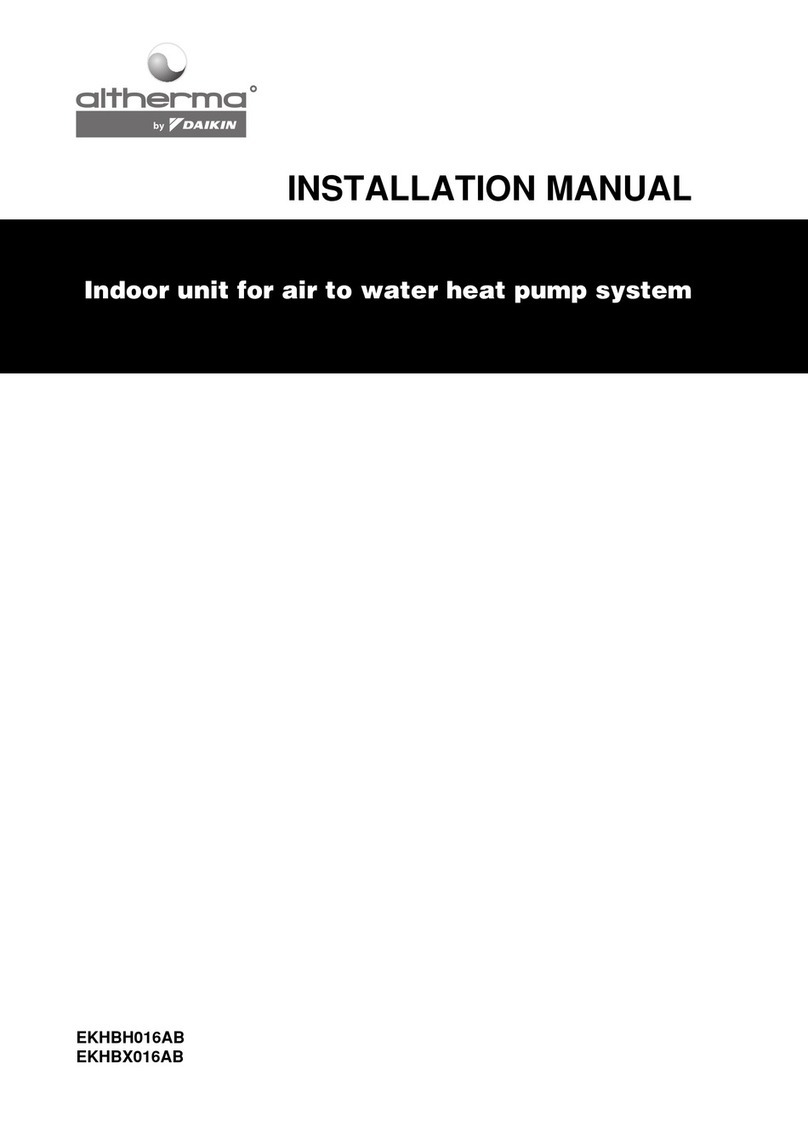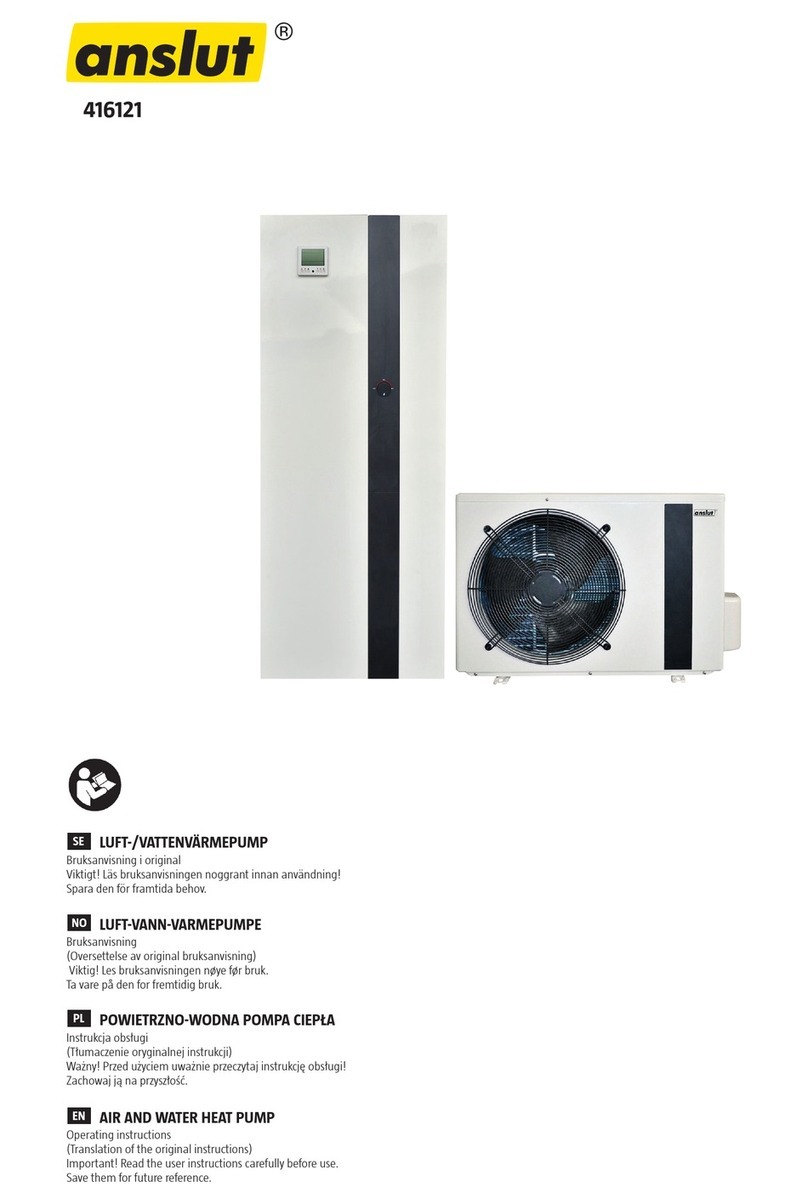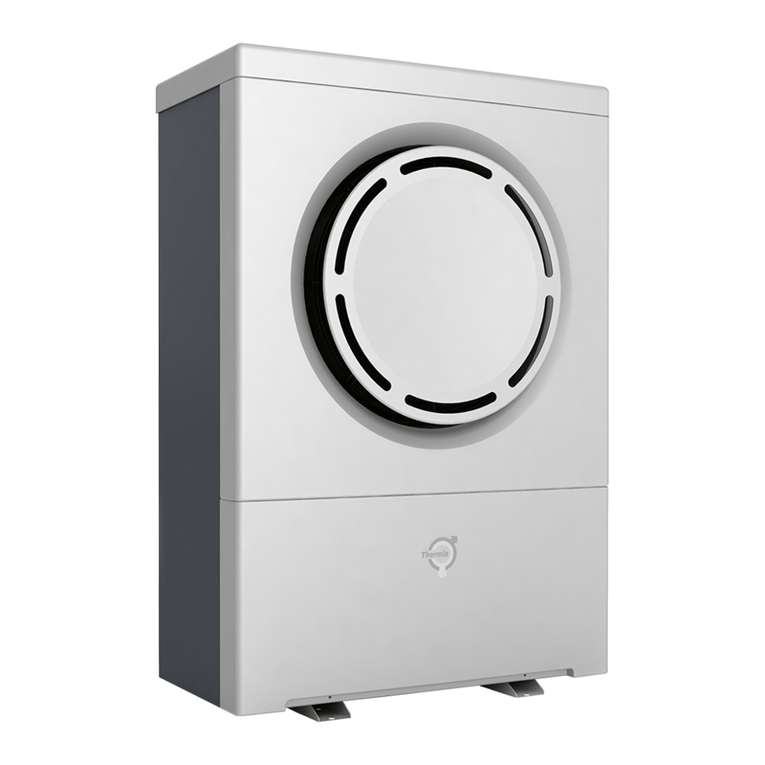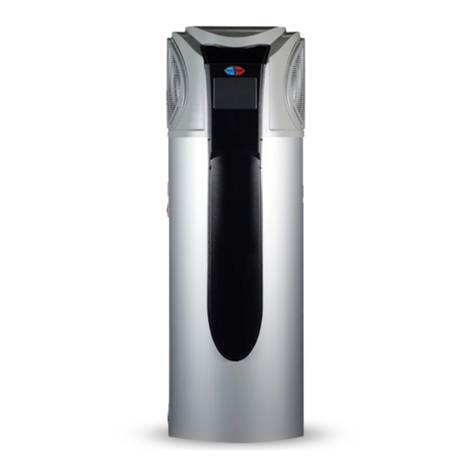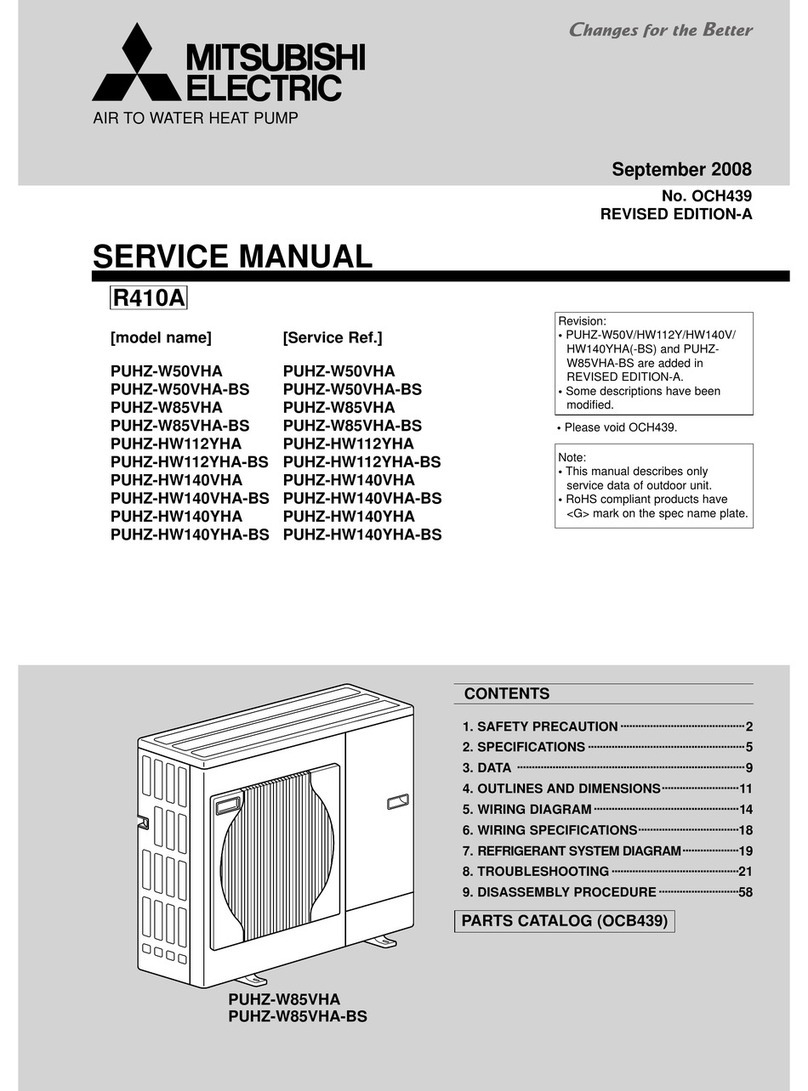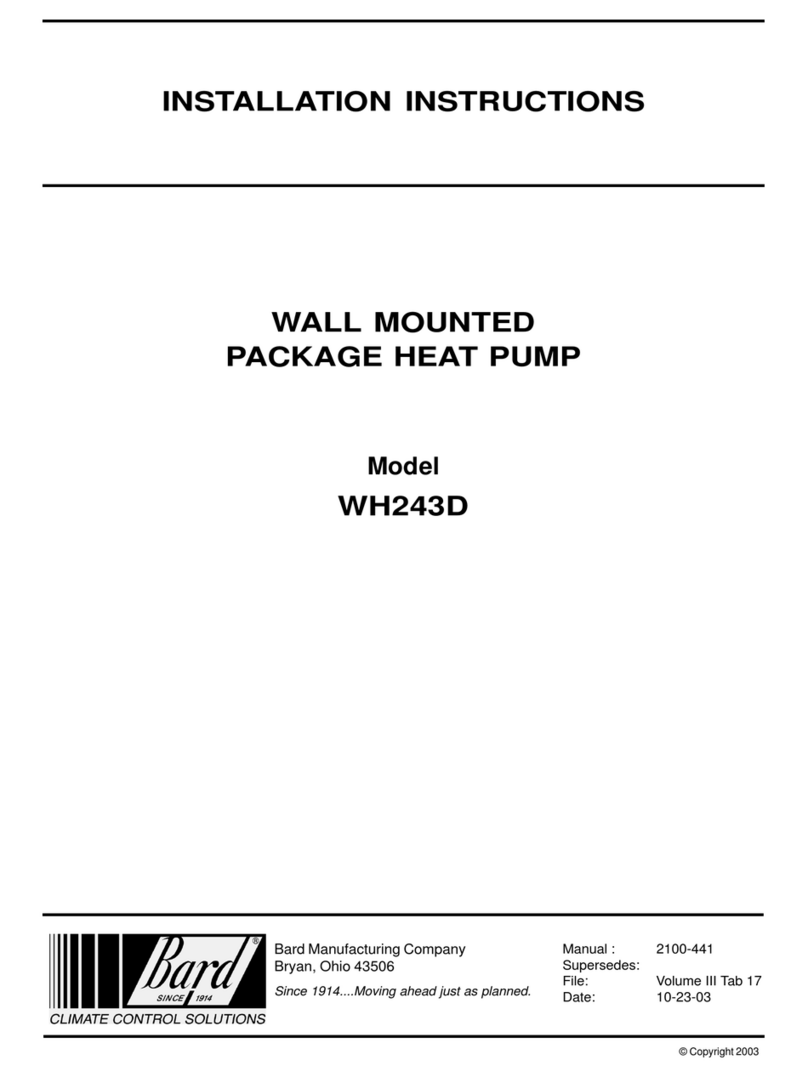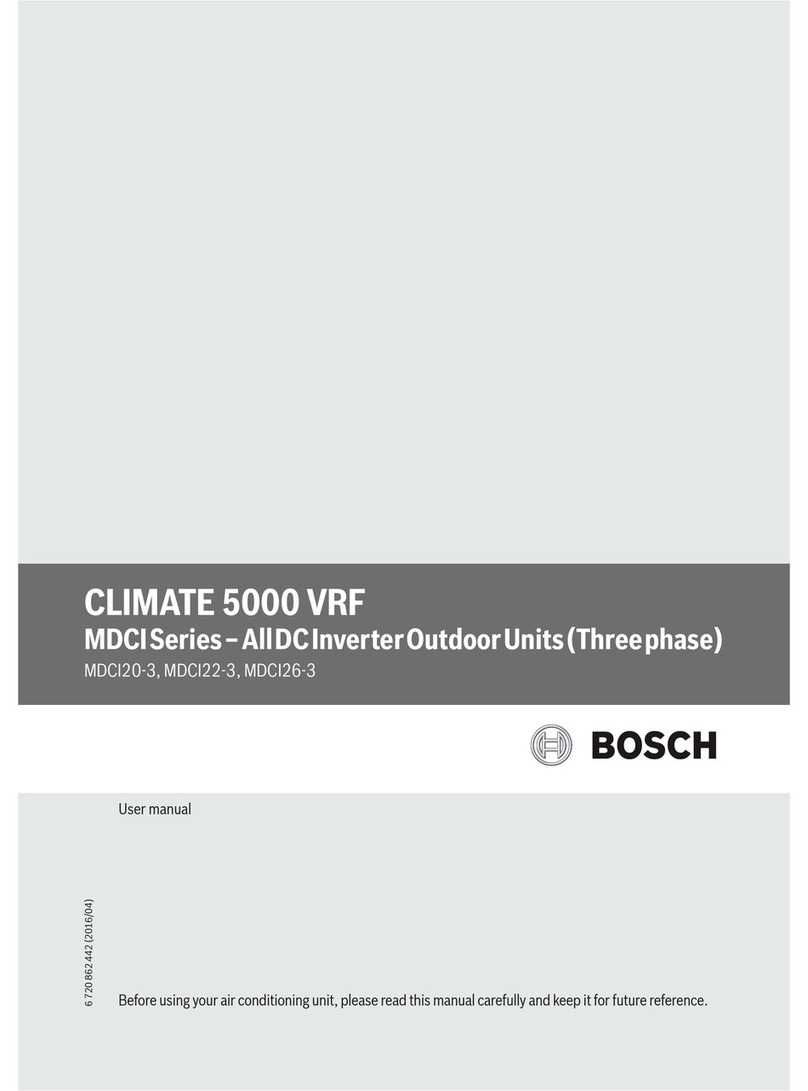ECOFOREST ecogeo basic User guide

MANUAL INSTALADOR
INSTALLER MANUAL
INSTALLERHANDBUCH
MANUEL DE INSTALLATION
INSTALLATIE-HANLEIDING
ES
EN
DE
FR
NL
ecoGEO Basic
MODEL:
04 / 2016 SOFTWARE VERSION v01_B23
SERVICE CONTACT:
ecoGEO Compact


Installer manual ecoGEO
34
EN
2. Heat pump installation
2.1. Transport and handling
The heat pump must be transported vertically and not exposed to adverse weather conditions. It can be lain carefully on its rear side
to facilitate transportation to the installation site.
NOTE
Do not tilt the heat pump more than 45º, since this could impair proper equipment operation.
Due to its heavy weight, the heat pump should be handled by two workers using a forklift for heavy
loads.
2.2. Dimensions and connections
The overall dimensions and hydraulic connections of the ecoGEO Compact and ecoGEO Basic heat pumps are described below.
Figure 1.1. Overall dimensions and hydraulic connections of the ecoGEO Compact model (Amounts in mm).
56
1736
64
139
462
537
282
720
63
175
300
425
1
2
8
7
3
4
9
10
11
12
1812
600

Installer manual ecoGEO
35
EN
Figure 1.2. Overall dimensions and hydraulic connections of the ecoGEO Basic model (Amounts in mm).
No.
Description
No.
Description
1
Heating / cooling supply; G1-1/4” Male
7
Tap water inlet; G1" Female
2
Heating / cooling return; G1-1/4” Male
8
DHW outlet (G1" Female)
3
Brine supply; G1-1/4” Male
9
DHW recirculation return; G3/4” Female
4
Brine return, G1-1/4 Male
10
Drain; φ16 mm
5
DHW exchanger intake; G1” Male
11
Power cables inlet
6
DHW exchanger return; G1” Male
12
Control cables inlet
Table 1.1. Hydraulic connections key.
All the models are prepared for pipe connection both at the top and at the rear.
The factory installation is prepared for connection at the top. To connect at the rear, the connection fittings installed at the top must
be exchanged with the blind cable glands installed at the rear.
2.3. Unpacking
To unpack the heat pump, remove the wooden box carefully, remove the pallet anchoring screws and perform a check to make sure
the heat pump has not been damaged during transportation.
710
53
950
538
82
157
273
348
463
1
2
3
4
5
6
10
11
12
600
1060

Installer manual ecoGEO
36
EN
Figure 1.3. Removing the screws fastening the heat pump to the pallet.
2.4. Assembly and disassembly of the covers
A Torx T20 screwdriver and a 10 mm wrench are needed to assemble and disassemble the covers.
ecoGEO Compact Models
1. Disassemble the top front cover. Remove the screws located at the upper part and pull the cover upwards.
2. Disassemble the bottom front cover. Remove the screws located at the upper part and pull upwards.
3. Disassemble the side covers. Loosen the screws and nuts located at the front and rear and remove the cover.
4. Once the covers have been removed, the acoustic insulation panels can be removed by pulling them outwards.
Figure 1.4. Disassembly of the covers of the ecoGEO Compact models.
ecoGEO Basic Models
1. Disassemble the top cover. Remove the screws located at the rear and pull the cover upwards.
2. Disassemble the front cover. Remove the screws located at the upper part and pull the cover upwards.
3. Disassemble the side covers. Loosen the screws and nuts located at the front and rear and top and remove the cover.
4. Once the covers have been removed, the acoustic insulation panels can be removed by pulling them outwards.

Installer manual ecoGEO
37
EN
Figure 1.5. Disassembly of the covers of the ecoGEO Basic models.
NOTE
During cover disassembly, take care to remove the control panel cable without damaging it.
2.5. Recommended positioning
Choose a dry place where there is no risk of frost. Avoid installation against bedroom walls or walls of other rooms where noise
emissions can be annoying. If possible, install the heat pump with the rear part pointed toward an exterior wall. Avoid installation
near a corner, since this can amplify noise emission levels.
The heat pump should be installed on a stable base that can support the total weight of the equipment and the operating fluids in its
interior. Use the adjustable legs to compensate for possible irregularities on the supporting surface.
Figure 1.6. Positioning and levelling the heat pump.
2.6. Service areas
The minimum recommended distances to be left around the heat pump to facilitate installation, start-up and maintenance work are
indicated below.

Installer manual ecoGEO
38
EN
Figure 1.7. Minimum recommended service areas around the heat pump (amounts in mm).
The space needed at the back of the heat pump can be either 50 mm or 300 mm, depending on which pipe connection alternative is
chosen, top or rear, respectively.
3. Hydraulic installation
NOTE
The installation schemes included from here on should be considered simply as a guide.
The design of the hydraulic installation must be performed by qualified personnel and in accordance
with applicable local regulations.
3.1. General instructions
The following recommendations should be taken into consideration for proper hydraulic installation.
Avoid excessive strain between the pipes and the heat pump connections to prevent leaks and/or transmission of vibrations.
Flexible hoses should be used for heat pump connections.
Install cut-off valves at all the hydraulic connections to facilitate future maintenance tasks.
Install traps at all the installation points where air pockets can form.
Place heat insulation on all circuit pipes to prevent unnecessary heat loss. Pay special attention to the heating insulation on
the brine circuit pipes, since these can reach temperatures below 0ºC, causing condensation and/or frost.
DANGER!
During installation work on the hydraulic circuits, take special care to prevent liquid from spilling on the
internal electrical heat pump components, which could cause personal injury due to electrocution
and/or poor equipment operation.
300
300
500
600
50 - 300
300
300
600
50 - 300
500

Installer manual ecoGEO
39
EN
Do not install components that might cover the inlet or outlet of the safety valves; this could lead to a
risk of some of its components breaking and cause injuries and/or material damage.
3.2. Brine circuit
The ecoGEO heat pumps can be used with horizontal or vertical (A) geothermal brine systems or by using groundwater (B).
Aerothermal brine can also be used by replacing the geothermal collector with one or more ecoGEO AU12 aerothermal units (C).
Finally, hybrid collection can be obtained by combining a geothermal collector with one or more ecoGEO AU12 aerothermal units
(D).
Geothermal brine systems
Brine systems with more than one circuit must be connected in parallel, so the flow rate through each one is similar.
Groundwater brine systems
Groundwater brine systems must use a midway exchanger to prevent the heat pump evaporator from corrosion, freezing or getting
dirty.
Hybrid brine systems
In hybrid brine installations, the aerothermal collector and the geothermal collector must be connected in series so the antifreeze
mixture circulates first through the aerothermal collector and then through the geothermal collector.
On the other hand, open / close 3-way valves must be installed between the outlet and return of each collector so the collector can
be bypassed when it is not in use.
Figure 1.8. Brine circuit connection options.
Integrated components
The following brine circuit components are included within the heat pump.
Variable speed and high efficiency outlet pump (energy class A).
Expansion vessel with a capacity of 8 litres, with pre-adjusted pressure of 0.75 bar (pressure gauge).
DO17
DO17
DO16
AO3
DO6
DO6
DO16
AO3DO16
C)
D)
A)
B)
3
4
3
4
3
4
3
4
3
4
3
4

Installer manual ecoGEO
40
EN
Safety valve loaded at 3 bar (pressure gauge).
Drain valve.
Installation instructions
Follow the instructions below to wire the brine circuit.
Install the necessary components to carry out the filling/discharge of the return pipe.
Install a particulate filter in the return pipe with a mesh size no greater than 1 mm. It is recommended to install shut off valves
immediately before and after the filter to make it easier to clean or replace.
Check that the volume of the expansion vessel integrated in the heat pump is capable of absorbing any overpressures from
the circuit. If this volume is not enough, install a supplementary external expansion vessel.
If necessary, adjust the pressure of the expansion vessel integrated in the heat pump to guarantee that the circuit remains
pressurised at all points.
3.3. Heating / Cooling circuit
The ecoGEO heat pumps can be connected to various types of heating / cooling systems, both directly and by separating buffer
storage tanks. On the other hand, these enable control over several devices that are external to the heating / cooling system directly
from the heat pump's electrical panel.
Heating / cooling system
The ecoGEO heat pumps are designed to be used with heating systems with nominal outlet temperatures of up to 55ºC; such as
underfloor heating systems, low temperature radiators or convectors. They are not recommended for use in heating systems that
require higher temperatures.
The ecoGEO heat pumps can be used with cooling systems with nominal outlet temperatures of up to 7ºC, such as convectors and
underfloor cooling systems.
Special care should be taken in the design and control in installations with underfloor cooling, to prevent problems of condensation
on floors.
The models that are not equipped with integrated passive cold allow control of external passive cooling equipment.
Direct installation
In simple heating / cooling systems, ecoGEO heat pumps can be installed directly into the distribution system, in systems with
underfloor heating, low temperature radiators and convectors.
Figure 1.9. Wiring scheme directly to the heating / cooling system.
DI12
DI11
T
T
DI10
DI9
T
T
DI8
DI7
T
T
DI6
DI5
T
T
FBus2
1
2
1
2
1
2
DO5
DG1
DO14
AO4
AI13
SG3
DO15
AO5
AI14
SG4
DO6
AO3
AI12
SG2
TT T
M
M
M

Installer manual ecoGEO
41
EN
Installation using buffer storage tanks
If required by the application, the heat pump can also be connected to the heating / cooling system using a buffer separator tank. To
do so, it is equipped with two temperature probes that are used to control a buffer storage tank for heating and a buffer storage tank
for cooling. In installations where there is only one buffer storage tank for heating and cooling, both probes have to be installed in
the storage tank. Install the temperature probes at the points where heating / cooling production begins. Heating / cooling production
is stopped by the return temperature probe installed inside the heat pump.
Figure 1.10.Wiring scheme using two buffer storage tanks.
Figure 1.11.Wiring scheme using a single buffer storage tank.
Outlet units
These can manage as many as four different outlet temperatures. This is done by managing one direct outlet unit and three combined
outlet units. The combined outlet units have to use modulating 3-way valves with an analogue signal of 0-10Vdc. Each outlet unit has
independent terminals for heating and cooling demands. These signals are supplied with 24Vac or 24Vdc voltage.
T
T
DO10
AI16
AI15
DO13
DO13
DO12
DI12
DI11
T
T
DI10
DI9
T
T
DI8
DI7
T
T
DI6
DI5
T
T
FBus2
1
2
1
2
1
2
DO5
DG1
DO14
AO4
AI13
SG3
DO15
AO5
AI14
SG4
DO6
AO3
AI12
SG2
TT T
M
M
M
T
T
DO10
AI16
AI15
DI12
DI11
T
T
DI10
DI9
T
T
DI8
DI7
T
T
DI6
DI5
T
T
FBus2
1
2
1
2
1
2
DO5
DG1
DO14
AO4
AI13
SG3
DO15
AO5
AI14
SG4
DO6
AO3
AI12
SG2
TT T
M
M
M

Installer manual ecoGEO
42
EN
Auxiliary equipment integrated in the heating buffer storage tank
This is used to control an auxiliary unit integrated in the heating buffer storage tank. It can be used for normal heat production or as
emergency equipment.
Auxiliary boiler
This is used to control start-up / stop of an auxiliary boiler and regulate final temperature downstream from the boiler by a 0-10 Vdc
modulating 3-way valve. The heat pump can use the boiler to assist in normal heat production or as emergency equipment.
NOTE
The hydraulic installation must ensure that while the boiler is operation, the temperature through the
heat pump never exceeds 65ºC, since this could cause serious damage to the refrigerant circuit.
Integrated components
The following heating / cooling circuit components are included within the heat pump.
Variable speed and high efficiency pump (energy class A).
Expansion vessel with a capacity of 12 litres, with pre-adjusted pressure of 1.3 bar.
Safety valve loaded at 3 bar (pressure gauge).
Drain valve.
Installation instructions
Follow the instructions below to connect the heating / cooling circuit.
Install a particulate filter in the return pipe with a mesh size no greater than 1 mm. It is recommended to install shut off valves
immediately before and after the filter to make it easier to clean or replace.
Check that the volume of the expansion vessel integrated in the heat pump is capable of absorbing any overpressures from
the circuit. If this volume is not enough, install a supplementary external expansion vessel.
If necessary, adjust the pressure of the expansion vessel integrated in the heat pump to guarantee that the circuit remains
pressurised at all points.
If there is an auxiliary system integrated in the heating storage tank, install a safety valve to protect it from any overpressures.
3.4. DHW circuit
ecoGEO Compact Models
The ecoGEO Compact heat pumps are provided with an integrated inter storage tank with a capacity of 165 litres, so it does not
require the installation of an external DHW storage tank.
ecoGEO Basic Models
The ecoGEO Basic heat pumps are designed to be used with external storage systems with a midway heat exchanger that can be
either internal or external.
DHW Recirculation
This is used to control a DHW recirculation pump. The storage tanks included in the ecoGEO Compact models are provided with a
separate inlet for DHW recirculation. If an external storage tank without a separate inlet for DHW recirculation is used, it is
recommended to connect recirculation to the cold water inlet pipe.
Auxiliary equipment integrated in the DHW storage tank
This is used to control a support system integrated in the DHW storage tank. This can be used as support to reach higher temperatures
during normal production, to carry out legionella protection programs or as emergency equipment.

Installer manual ecoGEO
43
EN
Figure 1.12.Wiring scheme of the DHW circuit.
Installation instructions
Follow the instructions below to wire the DHW circuit.
In the ecoGEO B models, install a particulate filter in the return pipe to the heat pump with a mesh size no greater than 1
mm. It is recommended to install shut off valves immediately before and after the filter to make it easier to clean or replace.
Install a check valve at the tap water inlet to prevent the possible return of hot water from the mains.
If necessary, install a safety unit (expansion vessel + safety valve) at the tap water inlet to prevent overpressure in the DHW
storage tank.
If there is a risk of scalding, a thermostatic mixing valve should be installed at the DHW outlet.
If the maximum system pressure can exceed 5 bar, it is recommended to install a pressure reducing valve in the mains inlet
to prevent overpressure in the storage tank.
If there is an auxiliary system integrated in the DHW storage tank, install a safety valve in the production circuit return to
protect it from any overpressures.
3.5. Pool circuit
The ecoGEO heat pumps can be used to send hot water directly to the pool production storage tank through an open / close 3-way
valve. It can be connected two different ways for this purpose, depending on the application. In both cases, the POOL mode must be
activated via a voltage-free signal from a thermostat.
Connection to the heating circuit (A)
In models that are not equipped with the HTR system, pool production should be connected to the heating circuit via an open / close
3-way valve. This type of connection allows non-simultaneous production for the pool on the one hand and heating or cooling on the
other hand.
Connection to the HTR system (B)
In addition to the option mentioned above, in ecoGEO Basic models with an HTR system, pool production can be connected to the
DHW circuit. This allows two options: exclusive pool production with the primary condenser and simultaneous heating / cooling and
pool production through the HTR system.
T
DO11
AI10
DO4
T
DO4
T
P
P

Installer manual ecoGEO
44
EN
Figure 1.13.Pool production wiring schemes.
3.6. Drain
Condensation may occur one certain internal heat pump components during normal operation. On the other hand, antifreeze mixture
or water may spill from the heat pump's internal safety valves due to eventual circuit overpressure.
There is a drain connection at the rear of the heat pump to evacuate these liquids.
4. Filling and discharge circuits
DANGER!
During filling work on the hydraulic circuits, take special care to prevent liquid from spilling on the
internal electrical heat pump components, which could cause personal injury due to electrocution
and/or poor equipment operation.
4.1. Filling the production circuit (heating, cooling, DHW and pool)
The heat pump is equipped with internal filling / discharge valves for the production circuit. It is recommended to use these valves
to ensure that the internal circuits are completely bled. Take the following steps to fill the circuit.
1. Open all the valves of the production circuits.
2. Fill the circuit through the filling valve until the target pressure is reached. Make sure that the pressure does not exceed 3
bar (pressure gauge) under any circumstance.
3. Remove the air from the circuit using the traps installed for that purpose.
4. Check the circuit pressure and repeat the filling process if necessary.
The ecoGEO Compact models are equipped with a manual trap at the entry to the coil to bleed the DHW production circuit.
T
DO11
AI10
DO4
T
DI4
T
DO2
B)
P
DI4
T
DO2
A)
DI4
T
DO2
A)

Installer manual ecoGEO
45
EN
Figure 1.14.Bleeding the DHW production circuit in ecoGEO Compact models.
4.2. Filling the brine circuit
The brine system temperature can fall below 0°C, so a mixture of water/antifreeze must be used. It is recommended to use propylene
glycol as an antifreeze additive or ethylene glycol with a corrosion inhibitor. Please check local regulations before using any type of
antifreeze mixture.
When preparing the mixture, be careful to calculate the volume of antifreeze necessary to reach the desired degree of antifreeze
protection. It is recommended to use a mixture with a freezing point at least 10ºC below the nominal minimum temperature.
Brine circuit filling should be done with the filling unit installed in the return pipe and an external circulation pump, taking the
following steps.
1. Prepare the appropriate proportions of antifreeze mixture in external tank A.
2. Connect the external recirculation pump outlet to valve D.
3. Connect a transparent hose from valve E to antifreeze mixture tank A.
4. Close valve C and open filling valves D and E.
5. Start the external recirculation pump and keep it running until the return is completely free of air and the antifreeze mixture
is mixed perfectly.
6. Open valve C and keep the external pump connected to remove the air between valves D and E.
7. Close valve E and pressurise the circuit to target pressure. Make sure that the pressure does not exceed 3 bar (pressure gauge)
under any circumstance.
8. Close valve D.
After completing the brine circuit filling process, it is recommended to check the concentration of antifreeze mixture again using a
refractometer.
Manual trap

Installer manual ecoGEO
46
EN
Figure 1.15.Filling the brine circuit.
4.3. Discharging the circuits
The heat pump is equipped with internal drain valves that ensure complete discharge of the various internal circuits.
3
4
A
B
C
E
D
3
4
A
B
C
E
D

Installer manual ecoGEO
47
EN
5. Electrical system
DANGER!
Before performing any operation on the electrical panel, disconnect the power supply.
5.1. General instructions
The locations of the main electrical panel components are shown below.
Figure 1.16.Location of the components in the electrical panel.
Several installation devices are controlled from the heat pump electrical panel. Some are internal and other are installed externally.
The internal components are connected to the electrical panel in the factory. Depending on the installation that the heat pump is
going to be connected to, in addition to the power supply, it may be necessary to connect various temperature probes (analogue
inputs AIxx), control signals from thermostats or other external equipment (digital inputs DIxx) on/off switching of pumps and/or
valves (digital outputs DOxx) or regulation of pumps and/or valves (analogue outputs AOxx).
The figure below shows a sample installation with the options for connecting external components to the heat pump.
DIxx
Digital inputs
AIxx
Analogue inputs
Distributor
230/400 Vac
Heat pump power
supply
Controller pCO OEM+
Fbus2
ModBus
communication port
Compressor driver
Inverter
Internal auxiliary
heater power supply
AOxx
Analogue outputs
DOxx Block II
Digital outputs to
relay
DOxx Block I
Digital outputs to
relay
Transformer 24 Vac
Electrical power filter
Controller fuse
Main switch
Controller expansion
module
Compressor contactor

Installer manual ecoGEO
48
EN
Figure 1.17.General electrical connections scheme of the heat pump (ecoGEO Basic models).
DO5
T
DG1
DO14
AO4
SG3
DO15
AO5
SG4
DO6
AO3
SG2
T
T
DI4
T
DO10
DO11
AI10
AI16
AI15
DO4
DO13
DO13
T
DO17
DO17
DO16
AO3
DO6
DO6
DO16
AO3DO16
TAI11
DO12
DO1 DO1
DI12
DI11
T
T
DI10
DI9
T
T
DI8
DI7
T
T
DI6
DI5
T
T
FBus2
DO2
P
AI13 AI14AI12 TT T
M
M
M
3
4
3
4
3
4
3
4

Installer manual ecoGEO
49
EN
Analogue inputs (AIxx)
These terminals are used to connect external temperature probes. Only passive NTC temperature probes can be connected, so cable
connection polarity is not important.
If necessary, use extension cables with a maximum length of 50 m and a minimum diameter of 0.75 mm2. For greater lengths (up to
120 m) it is recommended to use cable with a section of 1.5 mm2.
NOTE
Use original temperature probes only; other types of components could cause poor heat pump
operation and/or cause heat pump component breakdowns.
Figure 1.18.Example of temperature probe connections.
Digital control inputs (DIxx)
Digital signals from thermostats or other external devices can be connected to these terminals to control heat pump production
functions.
NOTE
Take special care with the working voltage of each digital input; improper handling could cause poor
heat pump operation and/or heat pump component breakdowns. Some digital inputs require voltage-
free signals, while others require 24Vac / 24Vdc signals.
Figure 1.19.Example of voltage-free digital input connections.
NOTE
Do not power external components connected to the digital inputs from the 24 Vac power supply of the
heat pump; this could cause poor heat pump operation and/or heat pump component breakdowns.
Com
Sgn
AIxx
NTC
Com
Sgn
DIxx

Installer manual ecoGEO
50
EN
Figure 1.20.Example of digital input connections with 24Vac / 24Vdc voltage.
Analogue outputs (AOxx)
These terminals send analogue 0-10Vdc regulation signals to modulate the control of outlet units with mixture, aerothermal brine
units with variable speed fan, external auxiliary boilers, etc. On the other hand, these connectors have a 24Vac power supply terminal
to supply the modulating valve motor.
Figure 1.21.Example of 0-10Vdc modulating regulation signal connections.
Digital outputs to relay (DOxx)
These terminals provide 230Vac activation signals for various external components, such as outlet units, open / close 3-way valves,
external auxiliary equipment, etc. The connectors used for valve control allow connection of any type of 2 or 3-point control valve,
as long as it has a single-phase 230Vac power supply.
NOTE
Pay special attention to the maximum consumption allowed by each connector. Use an intermediate
relay for the connection, if necessary.
Figure 1.22.Example of digital outputs to relay for A) circulator pumps and B) open / close 3-way valves.
GND
24Vac
Vout
AOxx
M
PE
N
L
DOxx
PE
N
Lin
Loff
Lon
DOxx
A)
B)
Com
Sgn
DIxx
24Vac
Com
Sgn
DIxx
24Vdc

Installer manual ecoGEO
51
EN
ModBus RS485 (FBus2) Communication Port
Internal terminals with thT bus communication data can be connected to this terminal.
5.2. Heat pump power supply
Depending on the model, the heat pump may require single phase 1/N/PE 230 V / 50 Hz power or three phase 3/N/PE 400 V / 50 Hz
power.
The heat pumps should be powered by an external automatic breaker that shuts down all the circuits. Shown below are the
recommended cable diameters for each heat pump model and the recommended range of external electric thermal-magnetic
protection. Maximum heat pump electrical consumption can vary widely depending on working conditions; for more information,
please refer to the Technical Service Manual.
Model
Electric
power supply
Cable
section
Maximum
current
ecoGEO B/C 3-12 kW
Single phase
4 mm2
16 to 25 A
ecoGEO B/C 5-22 kW
Single phase
10 mm2
25 to 40 A
ecoGEO B/C T 5-22 kW
Three phase
2.5 mm2
16 A
Table 1.2. Dimensioning of the power cord and the external switch.
To carry out the electrical installation, insert the power cable through the rear cover of the heat pump and pass it to the bottom right
part of the heat pump. Continue by connecting the cables to the power terminal block of the heat pump, as described below.
Figure 1.23.Power supply connection scheme in A) single phase and B) three phase models.
5.3. Internal auxiliary equipment power supply
The ecoGEO heat pumps are equipped with an internal auxiliary heater comprised by three 2 kW components each (6 kW in all) that
requires an independent power supply. This heater can be connected to either a single phase or three phase power supply, depending
on the thermal power required.
If the power supply is single phase 1/N/PE 230 V / 50 Hz, each of the elements can be connected independently to obtain 2 kW, 4 kW
or 6 kW, respectively.
A)
B)
L3
L2
L1
N
Power Supply
PE
L1
N
Power Supply
PE
Other manuals for ecogeo basic
4
This manual suits for next models
1
Table of contents
Other ECOFOREST Heat Pump manuals

ECOFOREST
ECOFOREST ecogeo hp User manual
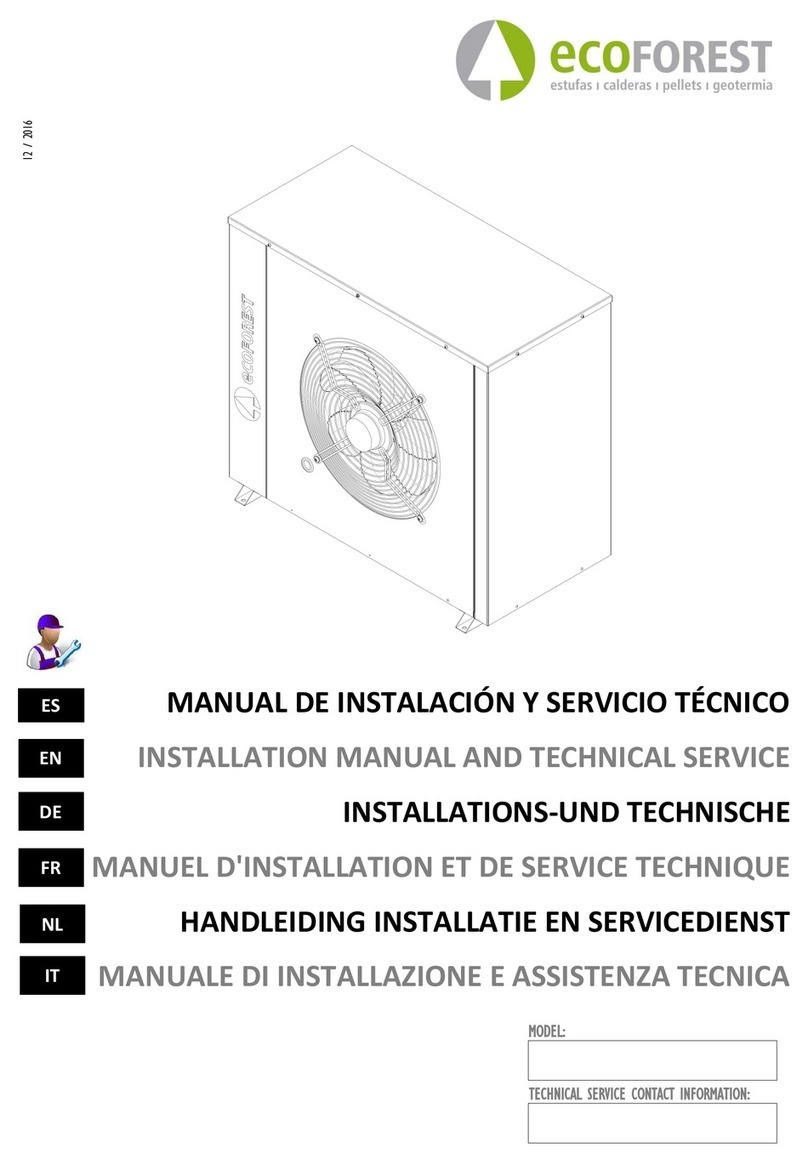
ECOFOREST
ECOFOREST ecoGEO AU12 User manual

ECOFOREST
ECOFOREST ecoSMART PSM Gen1 User manual

ECOFOREST
ECOFOREST ecogeo basic User manual

ECOFOREST
ECOFOREST ecoAIR EVI User manual

ECOFOREST
ECOFOREST ecogeo basic User manual
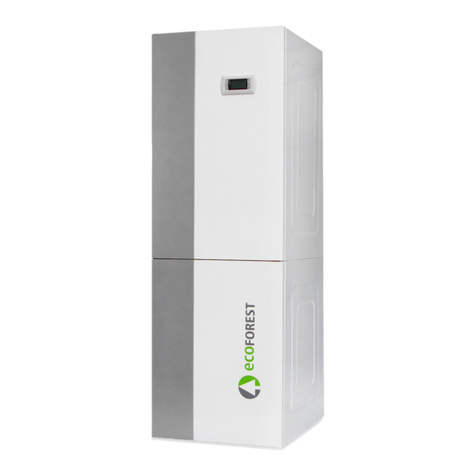
ECOFOREST
ECOFOREST ecogeo basic User manual

ECOFOREST
ECOFOREST ecoGEO B1 3-12 kW User manual

ECOFOREST
ECOFOREST ecogeo basic Operating manual

ECOFOREST
ECOFOREST ecoGEO C User manual

